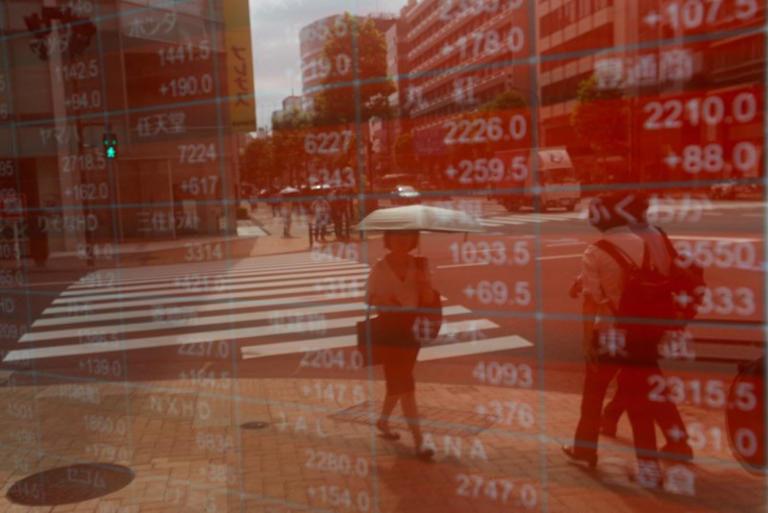Global stocks are on track for their best weekly performance since November 2023, as upbeat U.S. economic data has eased fears of an imminent recession, marking a sharp recovery from the previous week’s market turmoil. Investors, however, remain cautious about the potential for continued volatility.
The MSCI’s main world stock index surged nearly 4% over the course of five trading days, recovering from last week’s slump, which was triggered by concerns about a possible U.S. recession and volatility in foreign exchange markets. The rally was broad-based, with Europe’s STOXX share index climbing moderately in early Friday trading, on track for a 2.3% weekly gain. Similarly, Asian markets outside Japan posted comparable increases, while U.S. stock futures pointed to a strong week for Wall Street.
The VIX U.S. stock volatility index, commonly referred to as the market’s “fear gauge,” reflected the shift in sentiment, sitting at a benign level of about 15, a stark contrast to the four-year high of 65 it reached early last week. This decline in volatility suggests that investor anxiety has lessened, at least temporarily, in light of the more encouraging economic data.
The shift in market sentiment was driven by a series of U.S. economic reports that painted a more positive picture of the economy. Inflation data released this week indicated that price pressures were moderating, while robust retail sales figures suggested that consumer spending, a key driver of economic growth, remained strong. These developments have helped to shift the narrative away from recession fears, which were stoked by a weak U.S. jobs report in early August. Instead, there is growing confidence that the economy can continue to expand even as inflation eases.
The prospect of a so-called “soft landing” for the U.S. economy, where growth continues without a sharp downturn, has been bolstered by the recent data. However, some analysts, including Aviva Investors’ multi-asset portfolio manager Sotirios Nakos, warn that markets could still experience swings with each new economic data release. Nakos pointed out that the market quickly priced in more negative outcomes last week, only to rapidly unwind those bets this week. He also noted that thin trading volumes typical of the summer months may have amplified these market moves, suggesting that the recovery could be fragile.
In the U.S., S&P 500 futures rose 0.12%, setting the stage for an almost 4% weekly gain for the blue-chip index. Futures tracking the tech-heavy Nasdaq 100 also advanced, reflecting the broad-based nature of the recovery. Despite the improving economic outlook, markets have adjusted their expectations for Federal Reserve policy. While there is still a strong belief that the Fed will cut interest rates next month, the likelihood of an aggressive 50-basis-point cut has diminished, with the CME FedWatch tool showing a 25% probability, down from 55% a week ago.
David Chao, Invesco’s global market strategist for Asia Pacific ex-Japan, echoed this sentiment, stating that while the data supports the continuation of disinflation and an almost certain 25-basis-point rate cut in September, the chances of a larger cut have decreased following the release of the July inflation report.
In Asia, Japan’s Topix index surged nearly 3% on Friday, and the Hang Seng Index in Hong Kong rose by 1.8%. The Topix was on track for an almost 8% weekly gain, its best performance since March 2020, driven by a recovery from the heavy losses of the previous week. These losses had been prompted by a surprise interest rate cut from the Bank of Japan, which sent the yen soaring against the dollar and disrupted yen-funded stock trades. However, the Japanese currency has since eased to 148.96 per dollar, close to a two-week low, as the market stabilized.
In other currency markets, the Swiss franc, which also saw gains last week as investors sought safe-haven assets, was set to lose about 0.7% for the week. Meanwhile, the euro struggled to break above $1.10 against a firmer dollar, which had been buoyed by the robust U.S. retail sales report.
Government bond markets were relatively subdued as the return of confidence reduced demand for safe-haven debt securities. The yield on the two-year U.S. Treasury note, which is sensitive to interest rate expectations, hovered near its highest level in more than a week, at approximately 4.087%. The benchmark 10-year yield, which influences borrowing costs globally, was slightly lower at 3.907%. In Europe, Germany’s equivalent bund yield remained steady at 2.252%.
In commodities, Brent crude futures dipped 0.3% to $80.82 per barrel on Friday, while U.S. West Texas Intermediate (WTI) crude futures eased 0.4% to $77.84 per barrel. Despite these minor declines, both oil benchmarks were on course for weekly gains of more than 1%, reflecting ongoing demand and supply dynamics in the global energy markets. Meanwhile, spot gold rose 0.3% to $2,462 an ounce, as investors continued to seek the metal as a hedge against potential market uncertainties.
The overall market performance this week reflects a complex interplay of economic data, investor sentiment, and expectations for central bank policy. While the recovery from last week’s downturn is encouraging, the path ahead remains uncertain, with markets likely to remain sensitive to any new developments in the global economy.
